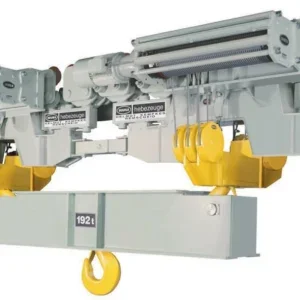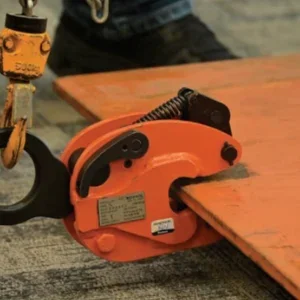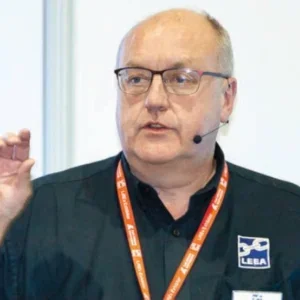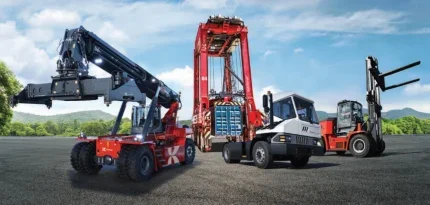
Europe has a rich and complex network of ports, sometimes with unique needs. It is also at the forefront of several key industry trends. For these reasons, it remains an important market for suppliers of cranes as well as cargo and container handling equipment. For historic reasons, many of the major lifting and handling equipment providers are also based in Europe, so its ongoing health is vital to their success.
“Europe remains a cornerstone of Kalmar’s global operations, despite our global delivery footprint with sales in over 120 countries and legal entities in more than 30,” says Carina Geber-Teir, senior vice-president, IR, and marketing at Kalmar.
Known worldwide for its heavy-duty forklift trucks, Kalmar operates several facilities in the region. One of its four assembly sites is in Stargard, Poland, and two of its global innovation centres are based in Europe, specifically in Finland and Sweden. Of its 5,207 employees at the end of 2024, 3,025 were based in Europe, highlighting the region’s significance.
“In the first quarter of 2025, Europe performed strongly and was our largest region in terms of orders, representing 47% of our first quarter’s order intake,” adds Geber-Teir. “In Q1 2025, Kalmar’s total sales amounted to €398m, and Europe represented 45% of consolidated sales.”
Hyster points out that the EMEA region accounts for around 34% of global revenue for the wider lift truck industry. The company’s regional operations in Europe include focused design centres, plus European production and parts operations.
“At Hyster we understand the bigger picture when it comes to the pain points facing intense industries, including the ports and terminals sector in Europe,” says Lucien M. J. Robroek, president, global technology solutions. “Our focus is on providing the best-fit solution for these specific applications.”
Chinese company XCMG Port Machinery says the importance of the European market is twofold, size and leadership. It believes that the market was worth around €5bn in 2024 and is forecast to reach €8bn by 2034. But equally as important is Europe’s influence as an early adopter.
“Numerous cases prove a lot of new technologies and solutions were introduced into the European market very early or even originated from that region,” says Shijie Zhao, deputy department head at XCMG European Sales and Services GmbH. “Through Europe’s experiences, they are later applied to other regions like Latin America, the Middle East and Africa.”
He says that this is why XCMG created its European sales and service division, as well as investing in a European R&D centre. “Europe has a good economic and social environments to pioneer the tech into practice,” says Zhao. “This makes both the suppliers and the users realise their extra value. In this way, Europe becomes the paradigm for other regions worldwide.”
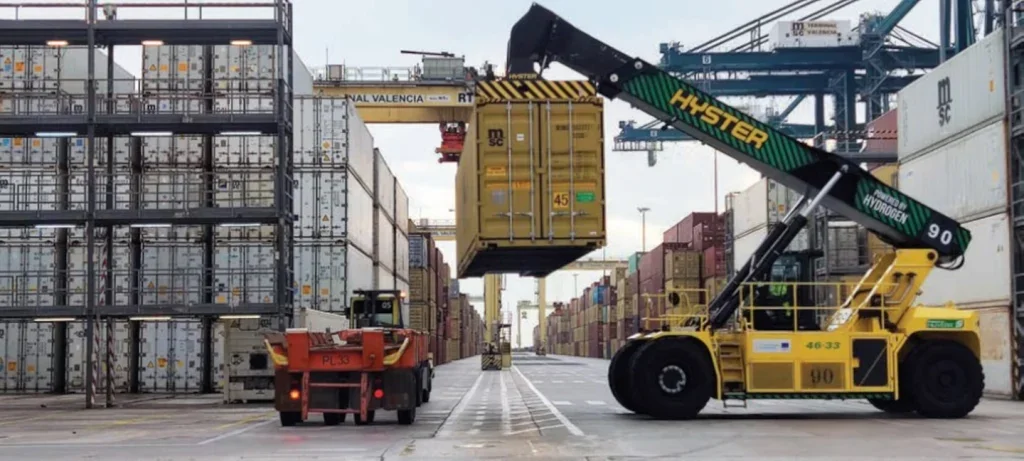
Kaleris provides software solutions to ports and has built long-term relationships with customers in Europe. “The European region is critical to Kaleris’ success as it serves as a hub for many of our long-standing terminal, shipping line, and ship operator customers,” says Ben Flanagan, EMEA sales manager at Kaleris. “These partnerships, cultivated over decades, have resulted in several joint innovations that have become industry best practices and standards.
“Europe consistently acts as a driver of innovation in terminal operating technology, with customers who are progressive and eager to adopt cutting-edge solutions. This proactive adoption accelerates technological advancement, making Europe an essential market not only for ongoing collaboration but for our business growth and leadership in the global industry.”
Dynamic region
The region’s unique characteristics can require a more tailored approach. “There is an old saying that once you have seen one, you’ve seen them all. That is not true of ports,” says Devon Van de Kletersteeg, product growth manager at CM Labs. “When you’ve seen one port, you’ve only seen one port! They are all a little bit different. In many ways European ports are some of the most dynamic in the world.”
Canada-based CM Labs is gaining ground in Europe as more port operators adopt its crane simulators and associated training packages.
“Europe has almost all of the big OEMs in the ports market; all the major manufacturers and component providers are here,” adds Van de Kletersteeg. “So, being present in the market is very important to us. We have had relationships in the past and have some right now with OEMS which have opened our eyes to the way their products are designed and how they work.”
The company has recently partnered with German manufacturer Spohn + Burkhardt – you can read more about this in our TOC Europe show preview.
Meanwhile, Kalmar is seeing growth across the board. “The growth and positive business sentiment in Europe are coming from all segments,” says Geber-Teir. “It’s not limited to ports only, but rather we have seen high activity in all four customer segments in Europe.
“Additionally, our strong service footprint has been performing well in Europe. A highlight is the mix between equipment and service sales, reflecting the broad demand across all four segments. We are pleased with the diversity of our customer segments, which supports stable and resilient growth.”
Part of this is down to continually reinvesting for the future. Kalmar puts considerable effort into electrification, digitalisation and automation to support the future needs of its customers, says Geber-Teir. It also actively pursues R&D to align with one of the key trends across all its market segments – developing more sustainable and efficient products with improved total cost of ownership.
“In addition to developing next generation products and services, Kalmar is actively following the industry and technology trends to identify, verify and test new technologies in order to be ready on time to implement such in the future offering,” says Geber-Teir.
Optimising space
Another characteristic common to European ports is a lack of space for expansion. “Land, regulation and infrastructure constraints make new terminal builds in Europe an increase rarity,” says Flanagan. “We work primarily with existing sites to further optimise their operations without having to expand their current footprint.”
An example is the Port of Helsinborg in Sweden. After implementing the Kaleris N4 terminal operating system (TOS), the port increased yard capacity by 30% and reduced rehandles by 50%.
“We also partner with terminals on their digitalisation journey,” adds Flanagan. “Depending on the type of operation, terminals may find themselves with a mix of solutions in play.”
A case in point was Rhenus Cuxport in Germany. As a multipurpose terminal, multiple legacy operating systems were in use simultaneously to handle different types of cargo. With Kaleris, all terminal operations are united in one system thanks to the implementation of its Mixed Cargo TOS. Now, breakbulk and container management workflows are centralised in one scalable and flexible solution that can be configured as the terminal needs it, managing complex handling workflows and billing requirements.
Another is APM Terminals Maasvlakte II, the world’s first fully automated terminal. They successfully went live with N4 4.0 from Kaleris in February 2025. “With this upgrade, the terminal laid the foundation to integrate new Automated Terminal Trucks (ATTs) and take further steps towards automating its rail terminal,” says Flanagan. “They noted this was a crucial step in their expansion journey, enabling them to double their terminal capacity.”
Hyster notes that container shipping overcapacity is also pinching both margins and space for ports and terminals. Figures from the EU indicate that the number of vessels calling in EU ports is increasing, as is the gross weight of goods handled. And with greater demand on shipping comes higher throughput.
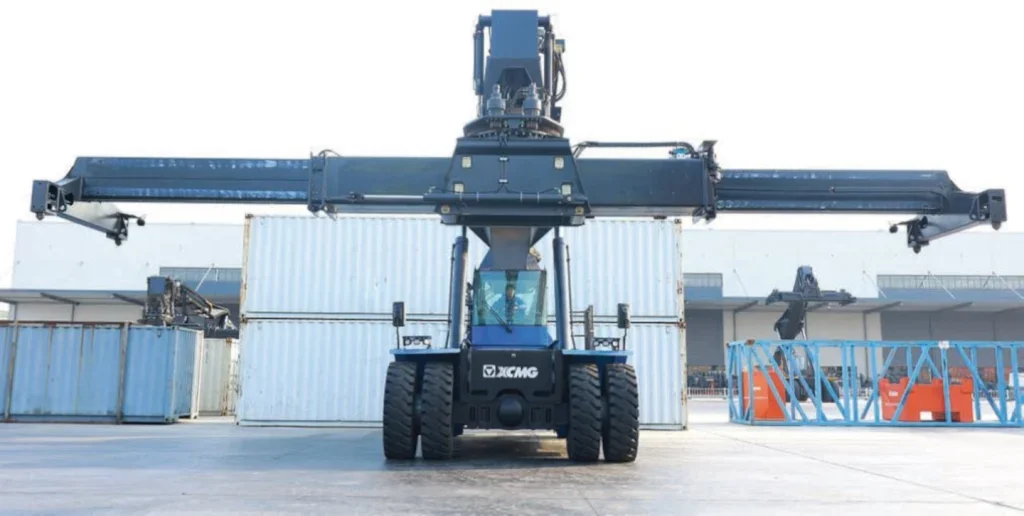
“Although some larger terminals are exploring more crane handling to deal with volumes, we also see more smaller ‘hub’ terminals appearing in some regions to help keep goods flowing,” says Robroek. “However, dependability and durability of equipment remain a high priority when selecting container handling equipment. That’s in our DNA and is one of the reasons why Hyster continues to be the first choice, even as the shipping industry evolves.”
Little differences
While dockside lifting and handling is a global industry, CM Labs sees several characteristics that are more pronounced in this region.
“There are some regions in which we operate where the objective is really to maximise productivity and safety,” says Van de Kletersteeg. “But in Europe, you have a very strong emphasis on the safety and sustainability of the ports rather than strictly on productivity.”
He cites the French regulations, CACEs (Certificat d’Aptitude à la Conduite d’Engins, a recommended training certification for operating material handling equipment). CM Labs has made sure that what is required for CACEs is included within its training packs.
“The other thing about Europe is that the level of investment is quite substantial,” he adds. “We want to make sure that we’re staying aligned with our customers and their present and future training needs.” Many customers purchase these training solutions before their equipment arrives. With a new STS or RTG crane often coming with long lead times, operators want to ensure that their workforce is fully trained before it arrives.
In addition, the continent remains at the forefront when it comes to tackling the big questions facing the industry. “Europe is the thought leader on some of the key issues facing ports,” says Van de Klestersteeg.
XCMG also believes in adapting to local values. “XCMG respects the culture and operation habit in Europe,” says Zhao. “We have been organising powerful local teams to execute this work.”
The company has designed and delivered six-high container reach stackers to Greece and Serbia, plus electric reach stackers and terminal trucks to its partner in the Netherlands. It has also established distributors in France, Spain and Italy.
Key trends
Two issues still at the top of every operator’s agenda are improving productivity and addressing sustainability.
“Momentum keeps growing for port electrification, whether driven by corporate initiatives or government targets,” says Robroek. “These deadlines aren’t immediate but shifting away from the ICE technology operations have depended on for quite some time requires taking a deliberate, thorough approach and doing your homework.”
He believes that Hyster’s new series of high-capacity electric forklifts represents a step forward for ports looking to go green. However, battery-electric forklifts are just one of the many ways that Hyster is helping operations to optimise their efficiency and power.
“We continue to closely collaborate with customers to develop a range of advanced, energy-efficient electric equipment,” he says. “Together, we’re aiming to create solutions that deliver the performance that intense industries demand, and the brighter tomorrow that our communities deserve.”
Chinese manufacturer SANY will celebrate the 15th anniversary of its European facilities next year. “The European market has always been strategically important to SANY since it opened the European facilities in 2011,” says Janko Weiss, product manager for mobile port equipment.
Since the launch of its electrification strategy by introducing the first electric reach stacker in 2023, SANY has steadily widened its portfolio of electrified machinery. The latest addition to the portfolio is the newly developed heavy-duty forklifts, with capacities from 10t to 35t.
“Thanks to the strong commitment to green technologies and ambitious environmental targets, the European region finds itself as a driver of decarbonisation through electrification,” says Weiss. “SANY continues to align with this trend and helps with Europe’s sustainability goals with the delivery of high performing and efficient equipment.”
Meanwhile, Flanagan explains how increased competition has driven the adoption of advanced technologies to improve operational efficiency. Many European terminals have also integrated some element of automation tools, not only to streamline processes but also to empower their workforce. Kaleris recently held a workshop in Europe where participants earned certification in automation expertise, fostering regional access to the best-qualified experts and underscoring the region’s focus on creating a tech-savvy workforce prepared for the future.
“Europe leads globally in sustainability initiatives, with regional legislation accelerating electrification and decarbonisation,” he adds. “However, many of our customers had already voluntarily committed to sustainable practices, understanding their long-term benefits before mandates took effect.”
This focus on technology and sustainability synergises well with Kalmar’s ethos. “The strong emphasis in the region on sustainability and digital transformation align closely with Kalmar’s strategic priorities: investing in sustainable innovations, expanding our service offerings, and driving operational excellence,” says Geber-Teir. “Our strong local presence and commitment to the region enable us to effectively support customers in their automation and decarbonisation efforts – both in Europe and globally.”
She believes that electrification and decarbonisation are leading trends in Europe, driven by strict environmental regulations and ambitious sustainability targets. This is reflected in the demand for Kalmar’s electric equipment portfolio, including electric reach stackers, forklifts, terminal tractors, and straddle carriers.
“In addition to emissions-free equipment, European customers are increasingly adopting intelligent automation and digital solutions to improve efficiency and reduce their carbon footprint,” she adds. “These developments go hand in hand with Europe’s push towards greener, smarter logistics operations.
“With a global installed base of 68,000 machines and a sales and service presence in over 120 countries, Kalmar is well positioned to meet these evolving customer needs and help drive the transition to more sustainable and automated terminal operations across the region.”
At the nexus of these two issues is digitalisation. “Improving preventative and predictive maintenance in ports and container terminals will be of greater importance as equipment availability and uptime are imperative for meeting customer demands,” says Robroek. “Digitalisation can provide significant benefits for the improvement of preventative and predictive maintenance of the equipment, by extending the operational lifetime of port equipment and machinery while improving reliability and reducing maintenance costs.”
Hyster is a participant in the iTerminals 4.0 Project, which aims consist of advancing the standardisation of processes and the application of Industry 4.0 technologies in the port container terminal industry.
SANY is also supporting this trend through its in-house service provider which has already digitalised port operations worldwide.
Positive outlook
Cargo handling has always been a dynamic business, and the current climate is no exception. Many major European ports are busy thanks to goods from China being rerouted. Originally destined for the US, exporters are playing it safe during ongoing tariff issues, by delivering them to Europe instead. This is playing into a more positive outlook than expected.
“The industry outlook for the European region remains positive,” says Flanagan. “Our customers continue to prioritise long-term gains over short-term occurrences, with operational investments focused on building success over the next decade. This forwardfocused mindset is reflected in projects aimed at enhancing operational efficiency, safety, and sustainability while managing short-term fluctuations.
“Although different elements may influence near-term operational decisions, they have not deterred investments in transformative technologies and infrastructure. European terminals exhibit resilience and adaptability, emphasising their crucial role in facilitating global trade by ensuring the efficient movement of goods. Their commitment to maintaining high levels of service delivery reinforces confidence in the future of the region’s industry.”
Kalmar is a little more cautious in its views. “Today there is an increased level of uncertainty in the market environment affected by the tariff announcements and geopolitical tensions,” says Geber-Teir. “Towards the end of Q1 as well as in the beginning of Q2, the uncertainty level increased. In certain parts of the world, customers are a bit more in the wait-and-see mode because of the uncertainty. We will see in the coming months what kind of business sentiment there will be in Europe.”
A temporary agreement on tariffs between the US and China will be seen as good news by Chinese exporters. “Ambitious infrastructure and sustainability goals will help to navigate through potential negative effects of the international trade tensions,” says Weiss. “With new megatrends, like smart infrastructure, electrification, environmental protection, and many AI-driven projects, we here in SANY look forward to long term economic growth and sustainability.”
XCMG sees that the European regional port machinery market is on the road to recovery. “We expect investment and equipment renewal to continue increasing,” says Zhao. “Tariffs above normal level are always sensitive to the investment, which adds extra costs and instability for business. But the investment issue is a very complex consideration; investors need to make a matrix calculation and then get their answer.”

While the question of tariffs remains, CM Labs does not see this significantly impacting the investment plans of European ports.
Van de Kletersteeg believes that no one is fully immune – but says CM Labs is fortunate because it is Canadian rather than based in the USA. “It’s not affecting our investment in the product, and it’s not going to necessarily affect our go-to-market strategy.”
“Essentially, a training simulator becomes part of the day-to-day operations of the port, and so in many cases, we see it is no longer really an option but an absolute necessity. We have a product that has a very well-defined need on a global level. And so, I think we’re going to be able to navigate these waters successfully in the future.”



